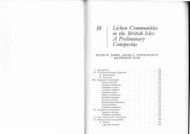You also want an ePaper? Increase the reach of your titles
YUMPU automatically turns print PDFs into web optimized ePapers that Google loves.
10 Squamules very robust, (300) 350-600 µm thick.<br />
Medulla hyphae almost exclusively with long<br />
cylindric lumina . 11<br />
10* Squamules thin, 200-400 µm thick, 2-6 mm<br />
broad. Medulla hyphae with numerous spherical<br />
lumina. Sp. 12-17 x 5.5-7.5 µm 12<br />
11 Sp. 14-17 x 6-8 µm. Squamules 2-7 mm, middle<br />
to mostly dark (red) brown, dull, <strong>of</strong>ten with<br />
bulging margin C. lachneum<br />
11* Sp. 15-20 x 7.5-9 µm. Squamules mostly 6-10<br />
mm, middle to dark brown to red-brown<br />
* C. rufescens (9)<br />
12 Squamules mostly somewhat raised at the<br />
margin, delicately hairy when young, mostly<br />
brown to orange-brown, dull. Pycn. sparse,<br />
indefinite, sessile at the margin <strong>of</strong> the squamules<br />
. C. pilosellum<br />
12* Squamules compressed, flat, commonly attached<br />
at the margins, not hairy, light to dark brown,<br />
dull or slightly shiny. Pycn. sunken in the<br />
squamule surface. Sp. frequently unripe .<br />
C. squamulosum<br />
Ecology and Distribution <strong>of</strong> the Species<br />
Catapyrenium cinereum (Pers.) Körber<br />
(Dermatocarpon c. (Pers) Th.Fr.)<br />
Above all in the montane to alpine sites on ±<br />
calcareous, soil surfaced rock bases on fine rich<br />
soils, <strong>of</strong>ten humus sites, on thin soil layer on<br />
calcareous rocks, <strong>of</strong>ten on weathered dolomite<br />
soils, going over to raw humus and moss, e.g. in<br />
openings on (semi)dry turfs, in pioneer<br />
communities on rock crowns (Alysso-Sedion),<br />
old rock rubble and on rubble surfaces,<br />
neutroph.-(m.)basiph., photoph., xeroph., e.g. in<br />
Toninion sed. – arct-med-alp – (v.)rare (3);<br />
above all FrJu; Ries, Ju, Do, Rh-Mn-t, He, Hz,<br />
Th; frequent in the Alps<br />
Catapyrenium daedalum (Krempelh.) B. Stein<br />
(Dermatocarpon d. (Krempelh.) Th.Fr.)<br />
In montane to alpine sties on calcareous subsoil,<br />
like C. cinereum (↑) and Physconia musc. (↑) –<br />
arct-mieur(alp)-(med-alp) – v.rare (1); FrJu,<br />
Ries, Al, Alps<br />
Catapyrenium lachneum (Ach.) R.Sant.<br />
(Dermatocarpon l. (Ach.) A.L.Sm.)<br />
In alpine sites, rarely lower, on soil surface raw<br />
soils, soil- or rock-mosses, plant detritus,<br />
commonly on base-rich substrates (geologically<br />
subsoil calcareous rocks or SiO2 poor silicate<br />
rocks); neutroph.-basiph., photoph. -- arct-mieuralp(-med-alp)<br />
– v.rare; Al, Vog<br />
Catapyrenium michelii (Massal.) R.Sant.<br />
(Dermatocarpon m. (Massal.) Zwackh)<br />
On fine soil and loess, like C. squamulosum –<br />
mieur-smed – v.rare (0); Ne, Do<br />
Catapyrenium pilosellum Breuss<br />
Like IC. squamulosum (↑) – mieur-subatl-med –<br />
rare, overlooked (1); süHü, Do<br />
Catapyrenium psoromoides (Borrer) R.Sant.<br />
(Dermatocarpon p. (Borrer) DT. & Sarnth.)<br />
Penetrating on deciduous trees with subneutral<br />
bark, but also (in the region) over mosses on<br />
limestone or soil surface raw calcareous soils on<br />
well lighted habitats; subneutroph.-m.basiph., r.v.photoph.<br />
– mieur-med – v.rare (1); FrJu, Ju,<br />
SJu<br />
Catapyrenium rufescens (Ach.) Breuss<br />
(Dermatocarpon r. (Ach.) Th.Fr.)<br />
Up into alpine sites on limestone, rarely<br />
calcareous silicate rocks, preferably on steep<br />
surfaces and on fragmented sites on well lighted<br />
habitats, <strong>of</strong>ten on sporadically irrigated surfaces,<br />
also on soil encrusted rocks, upon/with bluegreen<br />
algae, rarely on mosses or soil, like<br />
Lecidea lurida (↑), Toninia cand., Synalissa<br />
symph., predominantly in Collemation fuscov. –<br />
bor-med – r.rare; SJu-Ju-FrJu, Al, v.rare süHü<br />
süSch, Ne, Mn, Ts, MRh, Lahn, Th<br />
Catapyrenium squamulosum (Ach.) Breuss<br />
(Dermatocarpon hepaticum auct, non<br />
Endocarpon hepaticum Ach.<br />
Up into the montane, rarely alpine zone on<br />
calcareous soil, on naked loam soils, loess, on<br />
garden soils, in surface based rock soils, in<br />
regions <strong>of</strong> gravel surfaces on gravel pits, on soil<br />
layers on rock terraces etc., even going over to<br />
mosses and plant detritus, pioneer plants on open<br />
rich garden soils, weakly competitive, in<br />
openings <strong>of</strong> (semi)dry turfs, Alyso-Sedion, on<br />
mostly warm, moderately to very well lighted<br />
sites, subneutroph.-basiph., xeroph., in the<br />
Toninion sed. – (bor)mieur-med – r.rare: above<br />
all Ne, Hü, Mn; SJu-Ju FrJu, Eif, Ts, He, Th, Al<br />
Catapyrenium tremniacense Massal.<br />
(Dermatocarpon t. (Massal.) J.Steiner)<br />
In hilly and submontane sites on calcareous<br />
garden soils in lacunae <strong>of</strong> dry trufs and gardens<br />
soils <strong>of</strong> gravel surfaces, on base rich soils in well<br />
lighted, warm habitats, e.g. in the Toninio-<br />
144





